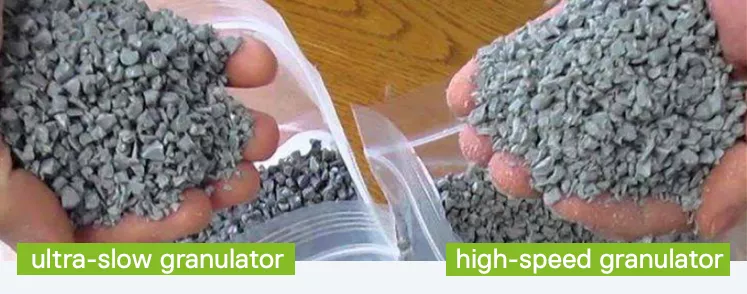Comparison of technologies: repelletizing vs. grinding
Injection molding materials are made from various plastics such as polystyrene, polycarbonate, polypropylene, polyamide and many more. Depending on the plastic Different technologies are used in recycling - grinding, shredding, regranulation, etc. .
Grinding is the most common processing method. However, there are some challenges. For example, depending on the grinding process, the dust content in the ground materials can have a detrimental effect on product quality in subsequent processing steps.. As a result, more and more users are convinced of the advantages of the regranulation process. The reasons for this are explained in the following blog.

Repelletizing instead of grinding
A method for processing injection molding materials that contain glass fibers is repelletizing. Using this method has several advantages.
The advantages of repelletizing
The following points highlight the advantages of repelletizing:
- Using recycled pellets increases the quality of the injection molded parts.
- Rejects are reduced by 20 - 30%.
- Follow-up costs are reduced if the parts produced are semi-finished products that are used in the automotive or electrical industries, for example. However, these costs are also reduced for rigid packaging and everyday items such as STABILO markers.
- The higher investment costs of the repelletizing system compared to the grinder are therefore amortized more quickly.
Processing with grinders
Grinders are often used to grind injection molding materials containing fiberglass. The problem with this method is that it produces fiberglass particles that are released into the air people breathe. This poses an enormous health and safety problem. To prevent this health risk, extraction systems need to be purchased. This, of course, means an additional cost for the processor.
Another disadvantage is that grinding often causes problems in the downstream process:
Variations in bulk density and pourability
Regrind material has a different bulk density and pourability than recycled pellets.
If the two materials are combined and used in an injection molding machine, the mold filling characteristics will deteriorate. The reason for this is that the combination of components does not ensure effective mixing. The result is a higher number of rejects.
And if the regrind material contains metal parts, they can damage the mold during re-injection. The reason for this is that there is no safety filter in the grinder system.
High dust content due to grinding
Suction intake and transport are more difficult because of the dust content.
- Dust and fine particles adhere to the intake duct of the injection molding machine.
- There they overheat and turn into soot particles.
- These cause black particles in the injection molded parts.
- As a consequence, the injection molded parts have surface defects.
- In addition, these particles frequently block the suction and transport lines.
Repelletizing vs. grinding: The advantages and disadvantages at a glance
| Repelletizing | Grinding | |
| Advantages |
|
|
| Disadvantages |
|
|